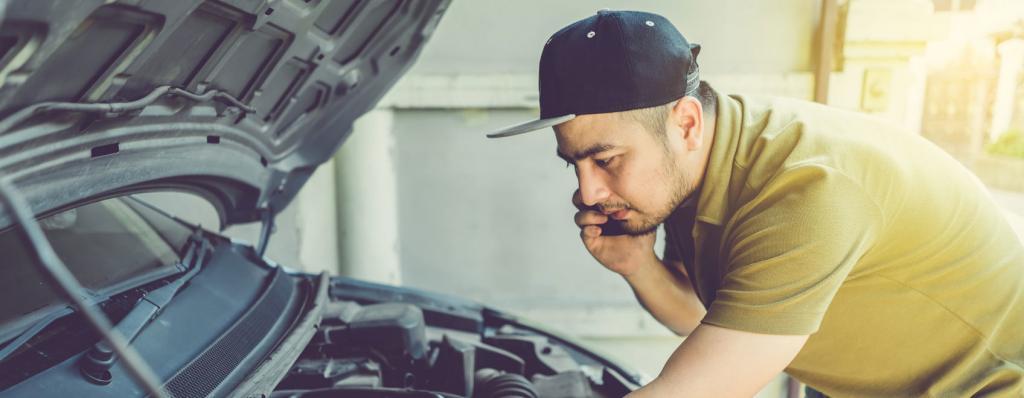Car maintenance is up there with unexpected vet visits and tooth ailments in its potential to unexpectedly and severely deplete your savings. The good news is by learning some very basic car maintenance tips you can not only avoid the expense that comes with paying professional mechanics for minor maintenance tasks, but also ensure your car stays in tip top shape and out of repair shops.
So roll up your sleeves and try out these basic car maintenance tips.
Get fairer car insurance. Based on how you drive
Exterior inspections
It’s not unusual to find out what’s wrong with your car via a traffic office who has just pulled you off the road.
This is one proven and accepted way to find problems on your car, but you can save yourself the trouble that comes with it by performing an inspection of your car about once every three months.
This doesn’t require in-depth mechanical expertise. All you need to do is:
- Check if all your lights are working. It’s easiest to have someone help you with this while your car engine is on and the car is stationary.
- Check your tyre pressure. The best way to do this is to purchase a tyre pressure gauge – they’re cheap and small. The recommended tyre pressure will typically be printed on your driver door panel. Remember to check your spare too.
- Check the tread thickness on your car. You can do this with a 20c coin. If the tread doesn’t reach up to the bill of the platypus on the coin, you need a new tyre.
- Check the area where your car is parked for recent fluid stains caused by leaks. Pay particular attention to oil stains.
- Start your engine and check if any smoke is being emitted via the exhaust system
- Check your windscreen wipers (these should not leave your windscreen streaky after use).
Check your fluids
Leaking or depleted fluids are bad news for your car. Fortunately, it’s quite easy to check them and prevent any issues before the occur. Most fluid containers are easy to find once you’ve popped the hood of your car, but if you’re not sure where to find them, your car’s use manual will fill in the blanks.
You’ll need to check::
- Oil (this shouldn’t just be at adequate levels but should also be clean and not muddy or murky)
- Antifreeze
- Engine coolant or radiator water level
- Power steering fluid
- Wiper fluid.
The containers for these fluids usually come with a gauge or a dipstick that will allow you to measure fluid levels. In some cases you’ll be able to tell just by looking that your fluid levels are low.
If you feel up to the job of replacing fluids, refer to your car user manual and it will provide you with the recommended product to use in each case. Many auto supplies shops will be happy to advise you on which product to use for your car.
Whatever to do ensure that you only attempt to replace fluids before you have driven your car or after you have given it time to cool down.
Rotate your tyres
It’s always a good idea to know how to replace a tyre on your car, and this gives you a good opportunity to practise.
Tyre rotation involves moving each tyre one position clockwise or anti- clockwise (the direction doesn’t matter as much as sticking to it at each rotation). Doing this every 10,000 km will wear your tyres evenly, resulting in longer tyre life and a smoother ride.
It’s also a good idea to balance your tyres once they are rotated. Balancing your tyres is not something you can easily do at home. So once you have rotated your tyres its recommended that you drive to a tyre dealership and have them check and correct the balance on the tyres. This process is quick and inexpensive.
Check your battery
While you’re looking at your engine take time to quickly check your batter (while the ignition is off).
Your battery will either be exposed or beneath a cover that can be easily unclipped. Perform a quick visual inspection of the battery. What you want to see is clean cylindrical battery terminals, and no mineral build-up on either the terminals or the clips that connect the battery terminals to the cables running to your engine. Also look out for frayed cables and any cracks in your battery case. You’ll also want to lightly push your battery to ensure it’s firmly mounted.
If you find mineral build-up on your battery, this is simple to remove using a custom brush that can be purchased at any auto supplies store. You may need a small adjustable spanner to remove the cell connectors before brushing the terminals and cell connectors.
Hazard lights
Newer cars have automated diagnostic systems that can alert you when something is seriously wrong with your car.
Don’t ignore hazard lights once they blink into life on your dashboard. The longer you delay having a potentially serious issue attended by a mechanic, the more damage it could incur to your car.
Drive safely
The old adage that prevention is better than a cure holds as true for cars as it does for humans.
Driving safely puts less strain on your car systems and helps to maintain them in good order.
Additionally safe driving can today earn your rewards through the use of free telematics smartphone apps like UbiCar. UbiCar records and scores your driving, giving you feedback that allows you to become a safer driver and rewarding you with fairer priced insurance that’s based on how well you drive.


